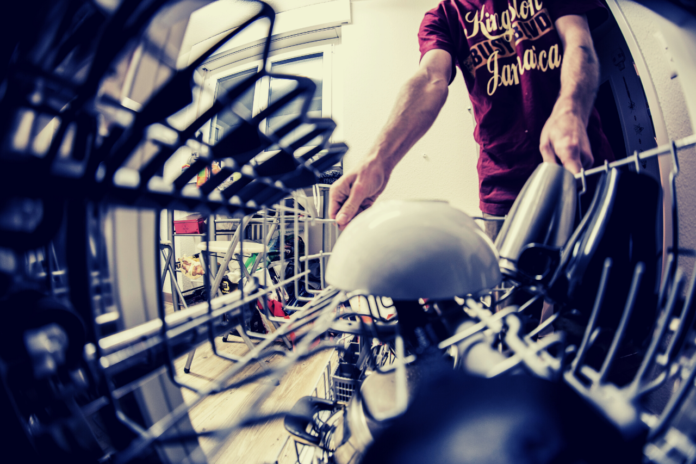A dishwasher is a miraculous contraption that relieves you of a time-consuming task that many people despise. Josephine Cochran, who created the first automated dishwashing in 1886, deserves credit. The dishwasher allows customers to load dirty dishes into it, and the dishes got cleaned without them seeing, thanks to spray arms, detergent, and other mechanisms. Have you ever wondered what happens when you shut the lid on your dishwasher, whether you’re attempting to fix a broken machine or just interested in your new purchase? Moreover, understanding how a dishwasher work might get crucial for using dishwashers to clean dishes effectively.
Continue reading to learn everything you need to know about this kitchen enchantment.
What Is A Dishwasher – The Need of Every Kitchen
A dishwasher is an unsung kitchen hero you can live without, but it’s not very striking. A decent dishwasher cleans and shines all those pots, pans, and dishes. Following a wonderfully made dinner is the primary thing people are terrified of in the kitchen.
Hand-washing your dishes not only takes a lot of time and work, but it also puts you at risk of breaking plates and coming into touch with toxins from your dish soap.
So, with a dishwasher, it frees up your time so you can focus on other tasks, spend time with friends and family, or do anything you want instead of standing in the kitchen alone for hours.
Hand-washing dishes all the time makes your skin harsh and dry. So, you’re not only conserving your skin, but you’re also safeguarding your hands.
How Does A Dishwasher Work? – Basics
Many individuals still wash their dishes by hand, as they did in the past. A dishwasher is essentially a robot that cleans and rinses soiled dishes. If you don’t have it, you’ll have to wash your dishes by scrubbing them hard and waste a lot of water.
However, the dishwasher does several tasks on its own. Of course, dishwashers are not available in every home, and you’re in luck if yours does!
The essential operation necessitates hot water, which may reach 130°F-140°F in a dishwasher. A dishwasher begins its cycle by bringing cold water into the machine through a hose.
Once a specific volume of water has accumulated in the machine’s bottom, a heating element begins to warm it up. Inside the dishwasher, there are two paddles: one under the bottom rack and one under the top shelf. When water enters the paddles, they spin around similarly to garden sprinklers.
The paddles create hot water jets that shoot upward onto your soiled plates. Water pumps around the machine for about half an hour until all the dishes and plates are clean.
Sensors in certain dishwashers can detect the dirtiness of the water flowing off the dishes. To prevent the dishwasher from overheating or harming your dishes, a timer controls the length of each cycle, and a sensor measures the water and air temperatures. These sensors closely monitor each step to ensure that everything is functioning well.
Now that you understand the principle of How Does A Dishwasher Work, let’s look at what happens throughout a dishwasher cycle?
Cycles of A Dishwasher
A dishwasher cleaning cycle has three basic steps that provide thorough dishwashing while using the few resources possible.
Cycle#1: Pre-Washing
Pre-wash is the stage of a dishwashing cycle that gets all the dishes wet without actually cleaning them. Using the rotating spray arms within the device, a pre-wash sprays the plates.
A pre-wash detergent dispenser comes in certain dishwashers to boost the cleaning power of this cycle. The machine’s computer timer automatically adds the detergent at the appropriate stage of the wash.
Cycle 2: Washing
The revolving arms of the dishwasher remove dirt and debris using hot water and detergent spray. Water is heated, sprayed in the primary wash that might take anywhere from 20 to 60 minutes, and the cycle may repeat numerous times depending on the setting selected by consumers.
All the water drains at the end of the main wash.
Cycle 3: Rinse
Clean water is pushed through the spray arms in the last cycle to ensure that no residue or detergent remains on the plates. While the spraying continues, the heater ultimately gets turned off.
The user will not have to dry or clean the dishes manually if they use an advanced dishwasher. Dishwashers use an electrical coil to heat the air, blown out by a fan inside the machine.
Additional cycles may get conducted depending on the manufacturer, but that is all for how a dishwasher work: in the cycle, most of the time
Important Components of A Dishwasher
To work effectively, some of the crucial component’s parts of the dishwasher that work together to get the desired results
Water Pump
Warm water from the sink pumps into the spray arms by the dishwasher’s pump. To eliminate any food stuck to the dishes, they get blasted with high-pressure water.
Cleaning the washing arms regularly is necessary to avoid blockages and increased pump pressure. If your dishwasher comes with a home repair guarantee, you should keep it in good operating condition to get the most out of it.
Mechanism and Valves
The control mechanism et concealed beneath the door’s control panel. Many devices employ a simple electro-mechanical system to regulate mechanisms. Some include kid safety locks, depending on the maker and size.
During a cycle, they get used to opening and closing the valve to let the proper amount of water into the system. Water pressure pulls the water into the unit when you open the valve.
Bottom Line
Dishwashers are available in both portable and permanent versions. A high-end dishwasher not only saves time but also adds aesthetic value to your property; which can help it sell faster. Clean dishes are ready to put away in no time, using a fraction of the resources required for hand cleaning, and get prepared for your next family dinner in no time.
Keep Reading: Similar Content You May Enjoy







![OGX Biotin And Collagen Shampoo Review [Updated One] Ogx Biotin And Collagen Shampoo Review](https://twinkyhome.com/wp-content/uploads/2022/03/Are-chicken-Super-Noodles-vegetarian-1-100x70.jpg)